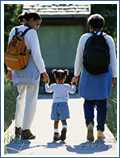Story Ideas - 2008
Many Notable Accomplishments, Many Challenges Ahead
CDC has faced many challenges and accomplished much in 2008. Many of you covered foodborne disease outbreaks, HIV rates and immunization coverage. Journalists and readers were very interested in obesity, autism and seasonal flu. We think the following stories are worthy of a closer look.

Going Green, Getting Healthy
"Going Green" was a big topic of conversation in 2008 as Americans focused on new ways to reduce their impact on the environment. CDC launched a "Go Green, Get Healthy" campaign to encourage employees to adopt new, healthier habits that are also "green." CDC is using its prevention expertise to address climate change and is preparing for the possibility of health effects related to climate change in the same way it prepares for the possibilities of bioterrorism and pandemic influenza.
Issues for 2009: What can your readers do to be more environmentally friendly – and healthier – in 2009? CDC will continue to research the impact of a healthy community, as well as the impacts of the environment on health. Meanwhile, your readers can take steps to “go green” and get healthy – and, like CDC, get their workplace involved, too!

The Ongoing Challenges of HIV/AIDS
In 2008, CDC released data that used new technology to give the clearest picture to date of new infections in the U.S. – and found that an estimated 56,000 new infections occurred in 2006, an increase of 40 percent over what we previously thought. This more precise data confirmed what we already knew: new infections in the U.S. remain far too high (although they have remained roughly stable since the late 1990s, which is a sign of progress). The data was a wake-up call to the nation that more should be done for HIV prevention.
Also, this year, our data showed that more than 1.1 million Americans are living with HIV, and that approximately 20% of those – 1 in 5 – are unaware of their infections. While undiagnosed infections have declined in recent years, too many who are infected remain unaware and may be unknowingly transmitting infection to others.
Issues for 2009: In the U.S., the impact of HIV and AIDS continues to be most severe for men who have sex with men, as they account for approximately half of new infections and of those living with HIV. African-Americans and Latinos are also significantly burdened. Continued reporting on the disproportionate burden for these groups is needed.

Prevention, Prevention, Prevention
Prevention is a message that bears repeating. Diabetes, obesity and heart disease were top stories in 2008. While chronic diseases are the leading causes of death and disability in the U.S., they are also among the most preventable illnesses.
Issues for 2009: Obesity will continue to be a big issue in 2009 – for kids and adults. And with obesity comes a greater risk of chronic disease. As baby boomers get older, prevention and treatment of chronic illness that tend to affect older Americans will become a hot topic. Chronic diseases have a huge, measurable impact at the local level, so prevention should be a community affair.

Smart Protection from Serious Disease
Immunizations and vaccine–preventable disease issues kept many CDC scientists busy in 2008. Flu vaccines were recommended for children up to age 18 for the first time and the shingles vaccine was recommended for senior citizens. Rotavirus cases were down in infants , most likely due to a new vaccine. We are seeing low levels of most vaccine-preventable diseases. Unfortunately, this success has had an unintended consequence: many parents and health providers are no longer familiar with these diseases – and some are questioning the need for, or timing of vaccines. This may be why more measles cases were reported in 2008 than during the same period in any year since 1996.
Issues for 2009:
Many reporters (and readers) still have questions on immunizations and vaccine-preventable diseases. The conversation over autism and vaccination is sure to continue, and parents will need balanced stories to help them make informed choices for their children. CDC experts are available to discuss these and many other questions.

CDC: Working All Over the World
2008 was a busy year for CDC employees throughout the world. CDC staff were present in more than 50 countries in 2008. Despite many challenges , like post-election violence in Kenya, an earthquake in China, and devastation after Cyclone Nargis in Myanmar, CDC continued its public health and global disease detection work.
Issues for 2009:
CDC will continue its work detecting disease and helping people throughout the world in 2009. We will keep working with foreign Ministries of Health to strengthen local public health systems. CDC will maintain active support of our Field Epidemiology Training Program . This program, modeled after CDC's Epidemic Intelligence Service , helps countries like Kenya set up dynamic public health organizations and train local public health workers to respond regional issues. Want to learn more about our global health efforts? CDC experts with international experience and interesting stories to tell are available for interviews.

Health for All, and All for Health
While great strides have been made in disease prevention this year, ensuring health equity and eliminating health disparities remain a challenge. In 2008, progress was made in vaccination coverage among minority groups, but there is still work to be done in many other areas.
Issues impacting good health go beyond insurance coverage and the availability of health care. Hypertension, infant mortality, and tuberculosis still affect African-Americans at disproportionate rates even when they have access to care. Today's youth are engaging in fewer risky behaviors like drinking and smoking, than youth in the 1990’s, but the numbers of Hispanic youth who drink alcohol and smoke remain comparatively high. And Asian-Americans bear the greatest burden of chronic hepatitis B. These examples of health disparities represent the need for multi-faceted approaches for improving health.
Issues for 2009: As a new year begins and America begins a new focus on healthcare reform, we must not forget the health disparities that exist today. The promotion of healthy behaviors, health equity , and awareness of cultural differences other social determinants of health will be topics of discussion for the New Year.
- Page last reviewed: January 13, 2014
- Page last updated: January 13, 2014
- Content source:
Error processing SSI file


 ShareCompartir
ShareCompartir

























